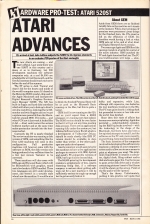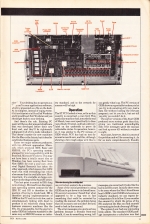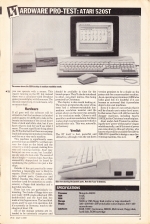
Personal Computer News
 11th May 1985
11th May 1985
Categories: Review: Machine
Author: Alan Turnbull
Published in Personal Computer News #110
It's arrived at last. John Lettice subjects the 520ST to his rigorous standards in an exclusive PCN preview of the Atari onslaught.
Atari Advances - The Atari 520ST
It's arrived at last. John Lettice subjects the 520ST to his rigorous standards in an exclusive PCN preview of the Atari onslaught

ST, Mouse and Disk Drives. The 1MB version is on the left. Note Breakout, peeking from below the control panel
The new Ataris are coming - and that's official. Last week there was one 520ST in this country, and a dozen or so in Germany, but 200 development machines (for software companies only, at at a cool $4,500) are scheduled for arrival this month, and the first full systems should reach end-users before the end of the summer.
The ST series is Jack Tramiel and Atari's bid for the hearts and minds of the world's computer users. It's based on the Motorola 68000 wonder-chip used in the Apple Macintosh and incorporates Digital Research's Graphics Environment Manager (GEM). The 520 has built-in floppy and hard disk interfaces which will allow you to link up to Atari's own low-cost drives. Link together a 520, monitor and twin floppies and you've got a system more powerful than the Macintosh for around £900. If it works - and when PCN saw it last week it looked like it did - Atari could corner the serious hobbyist market and at the same time make spectacular inroads into the business market.
Currently the ST is nearly finished. The review machine was running a disk version of GEM and something like the first 1,500 machines will come in this configuration. Full production machines will however come with the software on ROM, the disk version only being produced to buy sufficient time for a few last minute 'features' to be corrected.

Rear view, left to right: reset switch, power switch, power, Midi out,
Mini in, TV, channel switch (US only), RGB, Centronics, RS232, Floppy disk, Hard disk
These machines will also come with DR Logo and Personal Basic (which will be Microsoft-ish with graphics, sound and a few hooks to GEM) bundled. These two languages are still under development, and weren't in a testable state when I saw the machine. It would be nice to think the finished Personal Basic will be as good as the Microsoft Basic running on the Mac, but this is quite a target.
GEM itself is now running on the 520, and as you'd expect from a 68000 processor, it's running very fast indeed. The ROM version should be even faster, in that it will cut out any time-wasting disk-accesses. There are no applications running fully under the system yet, but Lifetree Software's Gem World, which is a development of Volkswriter Deluxe, should be ready shortly (the IBM PC version should be available in days rather than weeks). A few other packages are under development.
Atari's intention would seem to be for the machines to have a few applications packages in common with IBM, Apricot and sundry PC-compatible versions of GEM, but to go it alone beyond that.
The $4,500 price tag for development systems is symptomatic of this, Atari's reasoning being that, if a software company is serious about getting software out for a new machine it will be sufficiently serious to cough up enough loot to get an early look at it.
About GEM
Aside from GEM there are no finished twiddy bits on the machine as it stands at the moment. While Atari promises (if promises were processors) great things for the finished item, the STs stand or fall on the efficiency of GEM. It's therefore worth having a look at what GEM sets out to be, and at what Atari and Digital Research have at stake.
Two years ago Apple and IBM fired the opening rounds in a battle for control of the micro industry. IBM launched the PC and Apple launched the Lisa. The PC was traditionalism writ large - slow, bulky and expensive, while Lisa, although still expensive, was hailed as the way machines would go in the 80s. The PC was quite clearly a sitting duck but proceeded to more or less take over the world. Lisa bombed.
Since then this state of affairs has become even more perplexing. Apple has persisted - understandably, considering the R&D big bucks involved - with the technology in the shape of the Macintosh, but there have also been a few spirited attempts to install Lisa-like software on the PC and, more recently, on everything, home machines included.
The basic intention of the companies involved in developing this software is to duplicate a desktop on your computer's screen and to allow you to use a mouse to point at whatever you want. The minimum requirement is usually a calculator, digital clock, filing cabinet and/or disk and waste-paper bin. Use the mouse to point at the disk drive and a window containing pictures (icons) of the files on it will be shown on the screen. Point at the file and it will be 'opened'.
That's the theory. Unfortunately, putting it into practice isn't quite that simple. Your desktop has to operate as a 'front end' to your applications software, which is presented as a file on the desk. At its simplest, instead of typing WORDSTAR you'd point at a file called Wordstar and it would load. Exit Wordstar and you should get back to your desktop.
And there's the rub. Existing PC users will have a fair amount of software that was developed before their new front end, and they'll be righteously indignant if all of it is made redundant. This doesn't matter for new machines like the Mac or the Ataris, but it does for established business users.
Enter two major software producers, with two different approaches. Microsoft, which produced MSX Basic and MSDOS, the PC's Operating System, plumped for total compatibility with its front end, Microsoft Windows. This may not have been a totally smart idea as Windows has been coming Real Soon Now (RSN) for over a year now. Archrival Digital Research has taken the other approach, which means that GEM won't run with everything but which also means that it's available now. More important, it's available on home computers in the shape of the Atari ST series.
This last point is crucial to DR's long term strategy. Microsoft won the important Operating System contract for the IBM PC and DR is therefore in the position of having to break down. DR is therefore pricing implementations of GEM on the PC and its rivals low, and is simultaneously linking with Atari to produce it on relatively cheap home/business crossover machines like the STs. It's a big gamble, but the goal is to make GEM an industry standard in the same way as MSDOS became an industry standard, and so the rewards for success will be high.
Operation
The ST PCN looked at was, so far as this country is concerned, a rare bird. This particular machine had, towards the end of March, been sent specifically to Sam (son of Jack) Tramiel, and had a delivery label on the underside to prove its collectable status. In operation, however, it was similar to the PC version of GEM which PCN has had on test for around a month now, and this, although showing a few rough edges we'd like to see corrected, seems to be a success.
Some of the initial problems in using GEM can be put down to its friendliness. On several occasions I found that what appeared to be a bug was in fact something that could be corrected by reading the manual, the problem being that it's so easy to use you don't feel you need to look in the manual.
The error messages are a more serious problem because a friendly front-end should, if you do something wrong, tell you gently what's up. The PC version of GEM shows a regrettable tendency to let you try to do something silly (say, load a data file without loading the relevant program), not let you do it, but not tell you why you couldn't do it.
The earlier versions of the Atari GEM produced more serious goofs than this, giving you traditional unintelligible disk error messages (grab the manual and look up error 42) without a window in sight.
Atari says, however, that it is aware of the problem and will be correcting it. As far as more comprehensively friendly messages are concerned it looks like the ball is in DR's court. Initially there seem to be areas where the Mac's friendliness beats GEM's, but if GEM is to become an industry standard, we can expect developments of it to follow. If you consider the amount by which the prices of the STs undercut the Mac you find yourself not wanting to check a free nag's fillings.
The system I saw had one interesting little oddity. The standard GEM package incorporates a calculator icon that you can operate with a mouse. This wasn't running on the ST, but instead there was a calculator-sized Breakout game you could play with the mouse. The old style Atari Corp, it would seem, is by no means dead...
Hardware
If all goes well the software will be attractive, but the hardware is finished and it's poetry. It's difficult to take in the beauty and economy of the circuit board from a black and white shot, but if you know what to look for you'll see what I mean. The most significant thing about the PCB is the fact that there are no jump leads indicating last minute corrections, and this on a very early machine.
This machine is significantly more powerful than an IBM PC, yet there are very few chips on the board and the circuitry is widely-spaced, making for a very cool running machine. Atari may have put one over on me, but I couldn't see any sign of a heat-sink. The secret of this is simple - custom chips. Atari has successfully depopulated its board by condensing the gubbins into just a few chips.
Outside it has got practically every interface a reasonable user is likely to require. There's a TV output, monitor, twin joystick ports, Centronics and RS232. Besides this there are a Midi interface (used for connection to synthesisers), a floppy disk interface and a hard disk interface.
These last two are particularly interesting. Two kinds of floppy drive are now ready (500K single-sided and 1Mb double-sided) and the hard disk has made a brief appearance. The hard disk exists, and I've seen it in operation, but it's currently in Germany, much to the chagrin of Atari UK.
All of the storage systems are intended to be extremely cut-price and should be available in time for the launch proper. They'll also be interfaced to other, non-Atari micros, this being promised by Christmas.
The display is also worth looking at. The system pictured on the cover of this issue had a software-switchable low/medium resolution monitor and the screen shown on the cover was actually in low resolution mode. Colour is still possible in medium resolution, but there is also a high resolution monitor which is monochrome only. This was, naturally, in Germany.
Verdict
The ST itself is fast, powerful and attractive, although even the cut-down version promises to be a shade on the pricey side for a mass-market machine. As an operating environment GEM also looks good but it's doubtful if it can become so universal that it percolates down to low-cost machines.
Even if it does it's not certain that it will be of much use to entry-level users. In that sense there will still be room for cheaper machines, including Atari's 130XE, in this Christmas's marketplace.
Atari under Jack Tramiel is embracing the new 'power without price' slogan wholeheartedly, and if this sort of power can come down to this sort of price, who knows what will be available for £200 in 1986. If it's possible to design a sure-fire winning machine, this is it.
Specifications
| Processor: | Motorola 68000 |
| RAM: | 512K |
| ROM: | 192K |
| Storage: | 500K or 1Mb floppy disk (extra) or tape (standard) |
| Display: | 320 x 200/600 x 200 switchable colour display, 640 x 400 monochrome |
| Interfaces: | RGB, UHF, Centronics, RS232, Midi in/out, floppy disk, hard disk, ROM cartridge |
This article was converted to a web page from the following pages of Personal Computer News #110.








